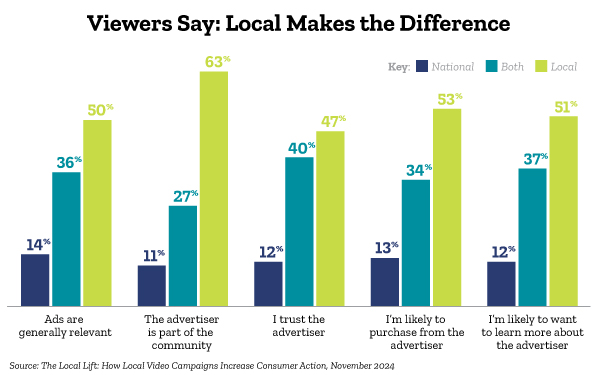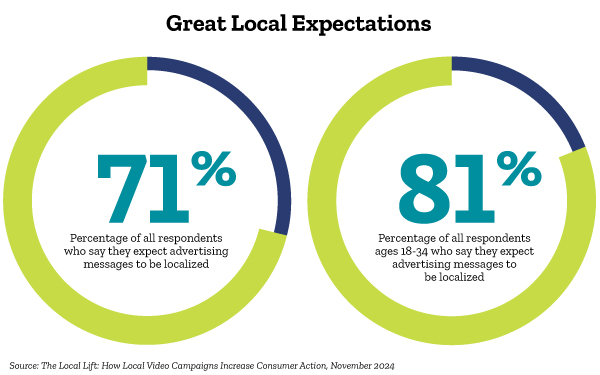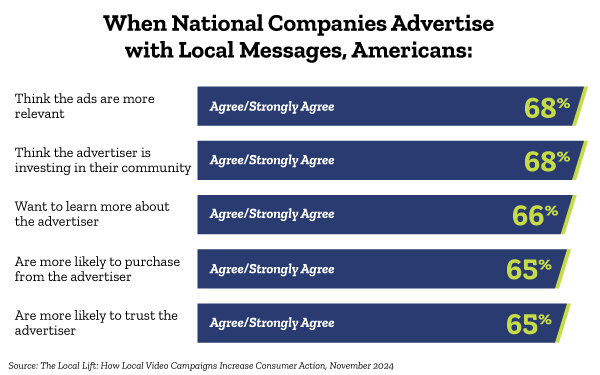How important is localized advertising to consumers—and why? Consider these findings from Locality’s new consumer research study, “The
Local Lift: How Local Video Campaigns Increase Consumer Action,” conducted by The Harris Poll:
- 68% of video viewers are extremely or somewhat engaged in their local
communities.
- 85% of video viewers believe it’s extremely or somewhat important to purchase from local businesses.
- 71% of all video viewers say they expect advertising
messages to be localized.
- Video viewers are 6 times more likely to say that brands featured in local ads are part of the community than are brands that only advertise nationally, and local
video ad viewers are 4 times more likely to trust those brands versus national advertisers.
- While only 13% of video viewers say they are likely to purchase from brands that only
advertise nationally, 53% say they are likely to purchase from advertisers that localize their ads.
“We watch culture at the Harris Poll all the time,” says
Jennifer Musil, managing director, Strategy and Go to Market, at The Harris Poll, a market research firm. “And we talk with consumers about a lot of
things, so the fact that people responding to this new survey are really invested in their local communities and like to support local businesses was not surprising. It’s very rare that we ask
something about interaction with local communities where people aren’t passionate about it.”
What Musil did find particularly interesting, however, was “how
much people trust local ads and how strong the impact is as indicated through their experiences with those businesses that took the time to localize a message.”
In
reflecting on the results of this research, which surveyed more than 1,000 U.S. video viewers 18 and older who watch at least one hour of TV weekly in October 2024, Shalyn O’Malley, Locality’s senior vice president of marketing, says, “the findings reinforced what we had anticipated in terms of local advertising driving relevance and
creating authenticity. But what we were hoping to see and were happy to discover is the extent to which local advertising actually influences purchase behavior.”

The Gen Z
Connection
While the majority of survey respondents indicated an engagement with local businesses—and with the brands that localized their ad campaigns—it
was the Gen Z and younger Millennials, between the ages of 18 and 34, who showed the most engagement and responsiveness—with 81% of them saying they expected localized ads, compared to 71% of
the general population.
Though she wasn’t surprised by this finding, O’Malley notes that others may have been. “There is a perception that younger viewers
aren’t as involved in their communities as older viewers are,” she says, “but clearly, according to the study, that’s not the case.” What’s made the difference for
younger audiences, she suggests, might stem from “the pandemic, where people started valuing their communities, creating more work-life balance, and getting more involved.” This, she says,
is a good sign since “Gen Z is our future; they’ve got a lot of buying power, so that’s something to pay close attention to—and a great way to do that is through local
advertising.”
Musil sees an additional force powering this trend. “The younger population has grown up with technology in a way where content is mostly personalized and
localized,” she says. “They’ve grown up with algorithms that feed them content that is specific to their interests and needs. And this bleeds over into how they expect advertisers to
speak to them through streaming and broadcast video versus just in the digital and
social channels.”
Underscoring this expectation, one young female respondent said, “Local ads make me more likely to pay attention and be interested in the brand
because I feel like they relate to me.”

How Do Brands Stay Authentic to the Communities They Serve?
While most respondents felt that localized advertising proved relevance and involvement
in the community and inspired not only trust but an interest in purchasing an advertiser’s products, a significant portion reported the need for the local message to express an authentic
interest in their communities.
“Viewers are pretty savvy” Musil says. “People are inundated with messaging and content everywhere they look, so the trick for
advertisers is to have some sort of meaningful localization to find those connection points with the community and then figure out how to produce ads accordingly, rather than blanketing national ads
treating everyone the same.” It’s not enough, she points out, “to say, I’m in Phoenix and I just slapped the Arizona Cardinals logo on something totally unrelated to football.
That doesn’t make any sense to the viewer. The connection has to be truly authentic.”
O’Malley agrees. “Every brand has its own authentic personality
and identity, and consumers are smart,” she says. “When they’re watching video ads that they feel are just not true or not in alignment with a brand’s identity, they’re
not going to feel right about it. It’s up to the brand to understand what their unique and authentic brand values are and connect those to local audiences. When a brand gets that right,
it’s super powerful, and that’s when we see the local lift and bigger engagement numbers for advertisers.”
To test the impact—and the perceived
authenticity—of local versus national ads, The Local Lift research study divided its sample into two equal groups, one of which was nationally representative and one of which was comprised of
viewers in a handful of selected DMAs. They then presented the national audience with national ads and the local audiences with ads that had been crafted to target their specific DMAs. In one test, a
Milwaukee, Wisconsin-based audience watched an ad for Culver’s, a local QSR, while the national audience saw a national ad with incentivized messaging focused only on the food. The
Culver’s ad, Musil explains, “was a simple localization, saying ‘Come on in. We’d love to see you,’ with a simple tagline, ‘From Wisconsin with love.’ They
made the ad feel like they were speaking to you in your community without ever directly saying it.”
And the impact? “With the Culver’s ad, the numbers showed
a significant lift,” says O’Malley: While similar percentages found the ads interesting and said they watched them until the end, 92% of respondents found the Culver’s ad relevant to
their community (compared to 78% for the national ad), 95% said they trusted the advertiser (compared to 81%), and 89% said they would consider Culver’s for their next QSR meal (compared to
75%).
Local Sports, Local News, Local Ads
While it was clear that local ads played well across all parts of the fragmented streaming
and broadcast video landscape, the survey highlighted two local programming options that provided viewers with particular relevance: sports and news.
“Sports is
inherently local,” says Musil. “It’s a safe place for brands to live.” That was also the conclusion of The Local Lift study, which found that 40% of respondents had a more
positive view of brands that advertised during local sports events (compared to only 4% with a more negative view) and 39% said they also trusted those brands more (compared to only 4% claiming a
decline in trust).
“News could be seen as being a little bit different,” Musil says, pointing to the months leading up to this fall’s election when “there was
a lot of discussion about brand safety in the news environment.” But a recent study conducted by Stagwell, The Harris Poll’s parent company, found that “ads placed adjacent to news
topics such as politics, inflation, and crime perform as effectively as those placed next to business, entertainment, and sports stories.” And Locality’s The Local Lift study bore that out
on a local level, with 43% of respondents saying they had a more positive view of a brand when it advertised during the local news (compared with 3% who claimed a more negative view) and 40% saying
they had more trust in brands that advertised during the local news (again, with only 3% claiming a decline in trust).

The Forces Behind the Trend
Localization, says O’Malley, is a natural outgrowth of changes in the industry. “The current environment, especially on the streaming side, is fragmented across a multitude of
services,” she says. “That’s why the ability to guarantee a more authentic relationship with consumers is more valuable than ever—there is simply no one-size-fits-all approach
anymore. With so many ways for consumers to engage with content, localization provides marketers with the confidence that their message is truly resonating with consumers, ultimately driving them
closer to making a purchase.”
Improvement in local ad creative has helped as well. As Musil notes, “local advertising has come a long way from the days when it was
seen as being low-quality creative. In The Local Lift study, we found a lot of great examples of national brands that are making the effort and doing some very successful local
advertising—really figuring out how to leverage that level of creative content on a local basis. That’s huge since consumers’ mindsets are already positive toward local
ads.”
Powering this, O’Malley adds, are breakthroughs in audience targeting and data as well as technology such as AI, all of which “have enhanced the way we
approach local advertising. Our goal is to get as close to the consumer profile as possible in a particular market. And we’re able to identify the markets where national campaigns are missing,
or underperforming, and then utilize local to fill in those gaps and deliver a level of incremental reach, creating the best-possible outcome for a campaign’s success.”
Where We Go from Here
In talking with clients and prospects about local advertising, O’Malley says, “independent agencies that have a
regional approach already understand the value of local. For some larger advertisers, the challenge may lie in integrating local within larger budgets or campaigns. We are optimistic that research
like this study will help make a compelling case for including local advertising as an essential component of regional and large, national media plans. The findings highlight the measurable impact and
value that localized strategies can bring advertisers of all sizes. Our hope is that The Local Lift study provides advertisers with actionable insights and a road map for planning local campaigns that
effectively connect with audiences and ultimately drive purchases.”
For a copy of the study reviewed in this article, “The Local Lift: How Local Video Campaigns Increase
Consumer Action,” click here. To read the other installments in this series, click here.